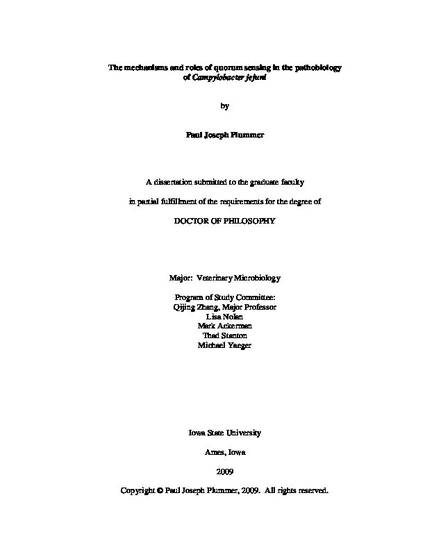
Campylobacter jejuni is the leading cause of food borne bacterial enteritis in the United States, as well as around the world, and is commonly contracted after consuming contaminated meat (especially poultry), unpasteurized milk, or contaminated drinking water. Since the ability of this bacterial species to respond to changes in the extracellular environment is paramount to its ability to cause disease, the mechanisms responsible for adaptation provide a viable target for bacterial control. The autoinducer-2 (AI-2) mediated quorum sensing system is widely conserved over both gram negative and gram positive bacteria and has been demonstrated to play a critical role in the environmental adaptation of other enteric pathogens such as Escherichia coli and Salmonella sp. Previous work has demonstrated that the C. jejuni genome encodes a functional luxS gene capable of producing AI-2 as a byproduct of its other role in s-adenosylmethionine (SAM) recycling, a normal metabolic pathway of bacteria. Several studies have started to evaluate the role of luxS and AI-2 mediated quorum sensing in C. jejuni, however many gaps still exist in our knowledge of how this system may play a role in the molecular response to environmental stimuli including in-host conditions. Work conducted as part of this thesis addresses three critical questions regarding luxS mediated quorum sensing of C. jejuni. First, we provide additional insights into the mechanisms of AI-2 synthesis by identifying a key amino acid of the LuxS enzyme that is critical for production of AI-2 in Campylobacter. Secondly, we demonstrate that luxS and/or AI-2 are critical to the competitive fitness and virulence of C. jejuni in two separate in vivo models of colonization and disease. Finally we evaluate the transcriptional and phenotypic changes associated with mutagenesis of this quorum sensing system and identify additional targets for future research to understand the function of quorum sensing in Campylobacter pathobiology. The collective results of these experiments complement each other and provide strong evidence for a critical role of the LuxS system of C. jejuni in environmental adaptation and pathogenesis.
Available at: http://works.bepress.com/paul-plummer/16/
